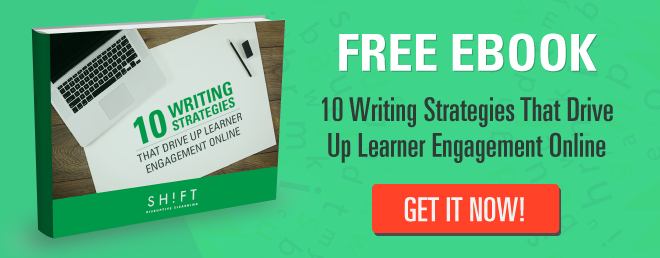While your dating life might be just a swipe away, you need to treat your clients like the ones you want to marry. An eLearning designer’s job is not merely to design a course but to interact with clients (internal or external) and create a product that not only fits but anticipates their needs. In order to do this, you need to work on your relationship, build it and maintain it.
With the tips you’ll find here, you will be well on your way to getting clients to say “I do” to your next project by working on creating good design and upping what you bring to the partnership.

1) Learn Through Listening
While your computer may be your BFF much of the time, at least half of your job as an eLearning designer is being able to communicate with clients. Being upfront and open will encourage your clients to do the same.
Let them know you are there to learn what they need and that their input is essential to creating a relevant course. There should be no guesswork as to what they want, and you should encourage them to tell you whenever they have an issue or concern because addressing it now before a course is live is the best way to fix things.
Getting constant communication and feedback will save you from having to make a laundry list of changes right before a deadline. It also keeps you on an even playing field with your client because while you are the expert in course design, they're the experts in their field. Keep them informed and keep yourself informed. With this, you may be able to reduce the time it takes to scope the project and create a learning strategy.
2) Leggo Your Eggo
Yes, we are all special, unique, little snowflakes, but in order to build an igloo we have to come together. Even if that metaphor left you cold (pun very much intended), you can see where I’m going with this. As an eLearning designer, you have a particular skillset and level of expertise, but you’re providing a service for someone else. Your value comes from how well you provide that service and you become more valuable when you can take criticism, remove emotions and let go of your ego.
By looking at your interactions from a business standpoint and not a personal one you will be better able to adapt to the criticisms and input you will, inevitably, receive. The natural ego you have as an artist can have its place in your personal projects. Making sure you save some time for yourself will give you an outlet and help ensure your mind is clear and ready to receive client input.
3) Deadlines Are Not Suggestions
While a winning smile might get you out of the doghouse with your significant other when you show up late, it’s not very likely the same tactic will work on a client. Ignoring deadlines will typically not only throw off your part of a project, but everyone else’s as well. And while the goal is never to be late with work, it is most critical in the beginning stages when you are building a relationship.
This is why it is so important not to promise more than you can reasonably deliver. It is tempting to try and offer more and faster when you are working to get a job, but your client will be infinitely more upset with late, shoddy work than they will be with adequately done basics in a reasonable timeframe. In that same way, you must also be able to tell a client that what they are asking for isn’t doable and why it isn’t doable. Just stating that something can’t be done isn’t nearly as effective as explaining that what they are asking for is unsupported by the majority of browsers or that it won’t look right in a certain format.
4) Build and They Will Trust
As we’ve discussed, a client relationship must be built and the bricks you build it with should be made of trust. When you foster trust you take the burden and worry away from customers who, in turn, will give you more work because they will know that you can deliver.
Trust, understandably, is a hard thing to achieve but like anything else, the hard things are most worth it. To earn trust you need to care and show that you do. This is not about simply providing lip service and saying the right things; it is about honestly believing in the importance of creating courses that will serve your client’s needs and recognize that helping their business/department to thrive will also help you succeed because you will become their go-to person for design.
You are likely going to be working with clients who have already had designers in the past. This previous experience can serve as a wealth of knowledge for you now and in the future. Find out what your client liked and didn’t like about past designers and possibly even what ended that last relationship. If they tell you that their previous client was always late or always imposed their own ideas, then you know that these are things you have to be especially sure not to do. Consider how defensive a person is when they have already experienced a partner who cheats. Your client may have trust issues because of a previous designer, so you need to take special care not to abuse what trust they are giving you.
Other key points to building trust include being a professional at all times, being respectful, consistent and present. Being present means that you give them your full attention when you are with them. Consider how you would feel about a dentist if they were poking around in your mouth while also talking on the phone. Would you trust them to a good job? Yeah, probably not.
5) Teach as well as Learn
eLearning Designers sort of have their own secret language, and sometimes we might even forget we’re speaking it until we have someone staring at us like we’ve started speaking in tongues mid-sentence. To help ourselves be understood and to understand our clients, we need to educate them on how to say what they really want and need.For example, a client might say that a color is too bright which might seem simple. However, as designers, we know that bright could refer to the saturation, value or hue itself as it relates to another color. Letting our clients know the difference will help them to express better what they want and to get a better eLearning course that more accurately suits their needs and preferences.
Teaching this terminology will show that you know your field well and are the right person for the job. However, it is even more important that you don’t talk down to your client. Try simplifying how you say things first instead of attempting to give a vocab lesson.
It is also good to let the client know about your process and the stages of design along with time estimates for each and when you will need feedback. This will give your client a better understanding and a sense of control and reliability. They will also now know when they will have to give approval at various stages before you can proceed which is especially important if their website will have to be down for certain phases.
Above all else, as you follow these guidelines for a good client relationship you must remain approachable and open to change and receive criticism. Be the kind of designer you would want working for you.
Other reads you might enjoy:
- 8 Signs You Were Meant to Be An E-Learning Designer
- Skills Your e-Learning Team Needs in 2016 and Beyond








